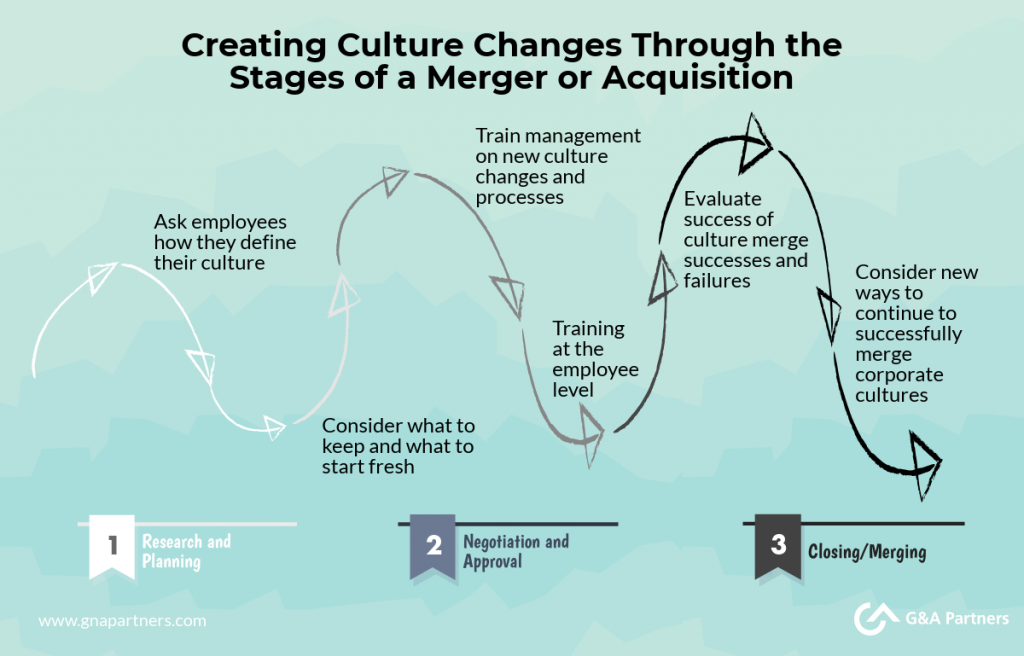Culture Clash: Mergers & Acquisitions
6 Tips for Integrating Company Cultures During Organizational Changes
“No matter how good the numbers look, the key to the realization of any acquisition [or merger] is the successful integration of cultures.”
This quote from an article written by G&A Partners’ co-founders hits at the root of one of the key reasons a merger or acquisition fails: a culture clash.
When we talk about company culture, we aren’t just talking about perks and benefits. Culture is about company methods, leadership style, processes, and operational objectives. Culture isn’t just ping pong tables and wellness programs – it’s the entire personality of the company.
Picture the following scenes:
- A large, national technology company acquires a smaller, more specialized internet company. One is used to a fast pace and turning projects on a dime. The other is more laid back and casual, with deadlines more of a goal than something set in stone. These two are headed for a culture clash.
- Two energy companies, headquartered in different parts of the world, decide to merge. One is based in a country with looser vacation policies and employment laws than the other. The second has been around a long time and is set in their ways. They are also headed for a culture clash.
- A private equity firm specializing in professional services has just invested in its first social media company. The new owners bring in advisors to help the smaller company put in new processes, but the employees are resistant. Another potential culture clash.
Why Culture Clashes Happen
The money is right and the investors are happy, but the employees are not. Before the terms of a contract have been signed, do your research. Investigate the cultures of the entities involved and decide how to move forward.

There are lots of ways to resolve culture issues, but you have to know what they are in order to prevent any major problems. By the time the ink is dry on the contracts, it might be too late to start addressing organizational conflicts.
Tips for Preventing a Culture Clash
1. Ask for Help
Identify the power players and influencers in each company and involve them in your planning stages, or hire a trusted advisor to guide you through the process, such as a Professional Employer Organization (PEO).
Another option? Appeal to your employees, who are likely feeling pretty emotional and worried right now, and ask them what they want to see moving forward. Send surveys, hold workshops – whatever it takes to get their feedback about where they see the company culture and what’s important to them. Continue to communicate with them throughout the integration process and keep them informed.
Learn how G&A Partners helped a county hospital when it transitioned from a larger hospital system.
2. Pick a Method: Your Way, My Way, a New Way
There are generally only three methods to handle two cultures coming together: keep one and discard the other, keep parts of each to create a new one, or start completely over with a new style for all parties.
Address your employee’s concerns. The very idea of two companies becoming one often brings to mind layoffs or redundancies, and people are likely to start looking around for something more stable. If you want to keep your top talent, you have to get them to buy into your plans for the new entity you will become. This means communication, training, and being honest with your employees.
Whatever you do, there will be pushback. Be prepared for pushback from not just your employees, but your clients. They might see this time of flux as a good time to renegotiate their terms or ask you for more than they were getting before. A company in turmoil is ripe for being taken advantage of, so be aware of where your weaknesses are.
3. Be Flexible
Few things run on schedule and the blending of two companies is not one of them. Recognize that timelines will need to be adjusted as the merger moves forward. Embrace trial and error – without occasional failures, you won’t learn what works and what doesn’t.

Remember that during the blending of companies, it’s easy to focus on just the short or the long term, but both should be of equal importance. Plan for both by establishing a long-term, flexible plan that includes immediate and future goals. Communicate these goals with your management and employees to make sure everyone keeps their eyes on what’s ahead.
4. Do Your Best to Keep People Happy
Two things often happen when employees hear the terms “acquisition” or “merger”: people leave, taking their knowledge and skills with them, and people start hoarding knowledge in an attempt to make themselves irreplaceable. To prevent these from happening to your organization, make sure you have documentation of processes and goals so that if personnel does shift, you are still covered.
Learn more about how to create a winning corporate culture.
Another thing to keep in mind is that your leadership might not stay put while your companies are adjusting. A company in the middle of a merger is ripe for people to decide to jump ship. Don’t take for granted that your managers will stay loyal to you during this time, especially if you don’t give them a reason to.
One of the biggest sources of frustration for employees of companies in either a merger or acquisition is employee benefits – especially if one of the benefits packages is richer or more robust than the other. Will everyone move to the same plan, or will the company retain two distinct benefits structures or packages? Aside from direct compensation (i.e. salary/wages), benefits are the thing employees consider the most when evaluating job offers and positions, so the benefits strategy a company chooses can be a crucial factor in the success of a merger or acquisition.
It’s not just your employees you need to keep happy. Client relationships are also at risk during a transition phase. The key here is to communicate with your clients as you move through this process to let them know what is going on. An ignorant client is more likely to leave than one that kept up to date on how your company’s changes will affect them.

5. Inter-Company Relations
As obvious as it may seem, remember that accounting and payroll departments are often run completely differently from one another. It is imperative that these two groups find common ground and ability to work together that also keeps your employees and clients happy.
Competition can be healthy – and it can break teams apart. As departments from different companies come together, it’s possible that competition could get in the way. One way to combat this is with team-building and getting buy-in from both sides on establishing the new company’s goals and processes.
This is especially important if you have offices in multiple states or countries, where the legal requirements might differ. You don’t want to ostracize some of your employees over unequal or unfair treatment.
Even if your offices aren’t subject to different employment laws, having multiple locations can be tricky. Make sure you are treating every office as equal as possible, and that communications between them are continuous. An intranet, a newsletter, and/or online collaboration tools can help bring even the smaller offices into the fold.

6. Make Training a Priority
One of the best ways to make sure everyone is on board with changes made as part of an acquisition or merger is to train them in the new methods. Even in an acquisition in which the acquired company will be adopting the processes of the acquiring company, every employee should be trained in the new way of doing things and trained together, if possible.
For instance, if your company is going to be shifting fiscal year-end, then the entire accounting department will need to review what processes they will be following. If employee reviews for one company were once a year, and the new company will be meeting every quarter, every person in management will need to go over the new system.
A successful cultural shift, whether through acquisition or other means, is dependent on multiple factors. You want to be sure most people are happy with the situation and morale is kept high. Company culture and all it entails is critical to the success of any growing business. Start your investigation process early and continue to communicate before, during, and after. Keep your employees in the loop and your new business will be far more likely to succeed.
Want to learn more about how we can help you with your organizational changes? Schedule your free business consultation today.
